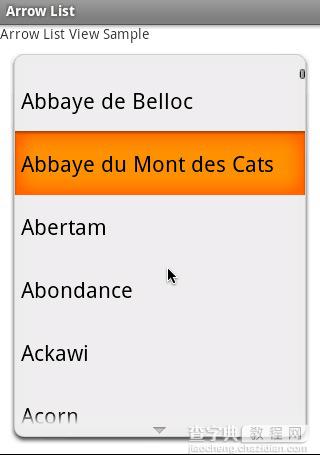顶部指示器?
这是什么?
好吧,我承认这是我自己想出来的词,因为我不知道它有什么学名,究竟是什么呢?看下这个图就知道了。

这是我们的美工MM画的,偶的神呐,这虽然很漂亮,不过也让人头疼,这个箭头应该在滚到顶部的时候消失,滚下来的时候(即有条目隐藏的时候)才显示,类似的底部指示器也要有这样的效果。事实上默认的ListView和ScrollView都已经有了类似的效果,在顶部或底部还有更多内容时,会有部分渐变虚化的效果,不过美工已经设计了这样的效果,那么我们就来做吧。
出于省事的目的,本教程中的例子会基于上一篇教程来修改,主要是添加1个继承自ListView的类,以及修改布局定义文件。
ArrowListView控件的编写
package net.learningandroid.lib.view; import net.learningandroid.lib.R; import android.content.Context; import android.graphics.Bitmap; import android.graphics.Canvas; import android.graphics.Paint; import android.graphics.Rect; import android.graphics.drawable.BitmapDrawable; import android.util.AttributeSet; import android.util.Log; import android.view.View; import android.widget.ListView; /** * 支持上下箭头的ListView * * <a href="http://my.oschina.net/arthor" target="_blank">@author</a> Mr. Lu */ public class ArrowListView extends ListView { private final float scale = getContext().getResources().getDisplayMetrics().density; private float topArrowPadding; private float bottomArrowPadding; private static float DEFAULT_TOP_PADDING_DP = 2.0f; private static float DEFAULT_BOTTOM_PADDING_DP = 2.0f; public ArrowListView(Context context, AttributeSet attrs) { super(context, attrs); String strTopArrowPadding = attrs.getAttributeValue(null, "topArrowPadding"); String strBottomArrowPadding = attrs.getAttributeValue(null, "bottomArrowPadding"); topArrowPadding = convertDisplayUom(strTopArrowPadding, DEFAULT_TOP_PADDING_DP); bottomArrowPadding = convertDisplayUom(strBottomArrowPadding, DEFAULT_BOTTOM_PADDING_DP); Log.v("ArrowListView", String.valueOf(topArrowPadding)); } /** * 单位转换 */ private float convertDisplayUom(String sour, float defaultValue) { try { if (sour.toLowerCase().endsWith("px")) { return Float.parseFloat(sour.toLowerCase().replace("px", "")); } else if (sour.toLowerCase().endsWith("dp")) { return Integer.parseInt(sour.toLowerCase().replace("dp", "")) * scale + 0.5f; } } catch (Exception e) { } return (defaultValue * scale + 0.5f); } /** * onDraw方法,根据ListView滚动位置绘出箭头. */ @Override protected void onDraw(Canvas canvas) { super.onDraw(canvas); Paint paint = new Paint(); // 取得箭头的图片,此处是固定图片,其实上可以做成配置方式 Bitmap topPic = ((BitmapDrawable) getResources().getDrawable( R.drawable.arrow_up)).getBitmap(); Bitmap bottomPic = ((BitmapDrawable) getResources().getDrawable( R.drawable.arrow_down)).getBitmap(); // 取得ListView的绘制区域大小 Rect r = new Rect(); this.getDrawingRect(r); // 计算箭头的绘制位置 float top = r.top + topArrowPadding; float bottom = r.bottom - bottomArrowPadding - bottomPic.getHeight(); float left = r.left + (r.right - r.left - topPic.getWidth()) / 2; // 计算是否需要绘制 boolean drawTop = false; boolean drawBottom = false; if (this.getChildCount() > 0) { Rect rTop = new Rect(); this.getChildAt(0).getLocalVisibleRect(rTop); Rect rBottom = new Rect(); View lastChild = this.getChildAt(this.getChildCount() - 1); lastChild.getLocalVisibleRect(rBottom); drawTop = (this.getFirstVisiblePosition() > 0 || this .getFirstVisiblePosition() == 0 && rTop.top > 0); drawBottom = (this.getLastVisiblePosition() < this.getAdapter() .getCount() - 1 || this.getLastVisiblePosition() == this .getAdapter().getCount() - 1 && rBottom.bottom < lastChild.getHeight()); } // 绘出箭头 if (drawTop) { canvas.drawBitmap(topPic, left, top, paint); } if (drawBottom) { canvas.drawBitmap(bottomPic, left, bottom, paint); } } }
就要点解释一下上面这段代码:
注意构造方法,我们必须继承public ArrowListView(Context context, AttributeSet attrs),这样才可以让这个类在xml定义文件中使用。
还要注意到,这里用了attrs.getAttributeValue来读取XML定义文件中的属性,其实有更好的方法,容我下次再讲解,这里先偷个懒。
convertDisplayUom方法是用来将dp转换成px的,可以看到由于我们用了getAttributeValue的方式,所以需要手动将String转成Float,很麻烦。
最后就是onDraw啦,计算出画箭头的位置,画出来就行了。
接下来就是布局文件的编写了
ArrowListView在XML文件中的使用
<"1.0" encoding="utf-8"?> <LinearLayout xmlns:android="http://schemas.android.com/apk/res/android" android:layout_width="fill_parent" android:layout_height="fill_parent" android:orientation="vertical" > <TextView android:text="Arrow List View Sample" android:layout_width="fill_parent" android:layout_height="wrap_content" /> <net.learningandroid.lib.view.ArrowListView android:id="@+id/arrowListView" android:layout_width="fill_parent" android:layout_height="wrap_content" android:paddingTop="15dp" android:paddingBottom="20dp" android:layout_margin="10dp" android:background="@drawable/float_panel" android:layout_weight="1" android:cacheColorHint="#FFEDEDED" android:divider="#00EDEDED" topArrowPadding="5dp" bottomArrowPadding="10dp" /> </LinearLayout>
这里需要注意的是自定义控件和其中的属性的写法,不再是ListView了,而是你自己编写的控件类的类名。其它的内容就是定义padding,background,以及取消了分隔线的显示。
用这个布局文件替代上一篇教程中的布局文件,但Adapter的定义不变,因为ArrowListView是继承自ListView的,所以原先的Adapter的使用是一样的。
最后我们来看下效果:

如何?只需要小心的调整ListView的Padding和ArrowPadding的值就可以控制箭头出现的位置,如果需要控制更多,比如更换图片,或者当顶部无内容时让箭头变暗、有内容时变亮,都可以用同样的方法。
并且,如果修改了Attribute的读取方法之后,还可以通过xml文件来指定箭头的图片。


